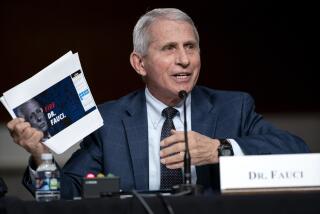Word of Mouth: ‘Contagion’ could really catch on
At one point in Steven Soderbergh’s pandemic thriller “Contagion,” Dr. Ally Hextall (Jennifer Ehle) gave herself an injection in such a rush that she doesn’t even roll up her pants. Dr. Ian Lipkin, one of the film’s science advisors, took one look at the scene and started, well, needling the filmmakers.
“They tried to persuade me that it was OK — that she’s in a real hurry,” said Lipkin, the director of Columbia University’s Center for Infection and Immunity. “And I said, ‘No, no, she’s not in that much of a hurry.’” At Lipkin’s urging, Soderbergh reshot the sequence.
In a movie filled with epidemiological lingo like R naughts (the rate an infectious disease spreads), three-dimensional and mathematical models of a killer virus (the film’s fictional bug is called MEV-1) and dialogue about encephalitis, genetic mutation and fomite transmission (where pathogens move by contact with inanimate objects), “Contagion” blunders could pile up as fast as the film’s body count.
So Soderbergh and screenwriter Scott Z. Burns decided to make the movie as accurate as possible without turning “Contagion,” opening Friday, into a med school lecture or a documentary. Instead, it’s intended to be a terrifying drama that could have been ripped from tomorrow’s headlines: Not only is this kind of pandemic possible, but it’s also likely, according to experts.
Movies traveling in scientific waters often sacrifice — if not torpedo — accuracy for dramatic effect. The asteroid assault in “Armageddon” is obviously hokum, and no matter how much you liked “Source Code,” time travel, even going back for just eight minutes, isn’t a reality. But junk science infects a number of medical movies that presumably have tried to cross their technical Ts and dotted their immunological I’s. Lipkin, for one, says the viral explanations in 1995’s “Outbreak” “made no sense at all.”
“Contagion” is essentially three interlocking narratives, weaved together like Soderbergh’s 2000 drug war drama “Traffic.” The first plot follows the virus as it races around the globe, infecting and killing its victims at a terrifyingly fast rate. The second tale focuses on the medical, epidemiological, governmental and civilian response, principally the work done by Atlanta’s Centers for Disease Control and Prevention and Geneva’s World Health Organization, as doctors try to slow the virus’ spread and identify its point of origin. The final story tracks the plight of Mitch Emhoff (Matt Damon), who’s desperately trying to keep the only other member of his immediate family alive.
Audience tracking surveys show that “Contagion” is poised to finally knock “The Help” out of first place this weekend. The pre-release data show strong interest in Soderbergh’s film from all demographic groups, a rare feat, with older women almost as interested in “Contagion” as younger men. Buoyed by early test screening scores, Warner Bros. moved up the film’s release date by more than a month, and the film should benefit from the strong early reviews it is generating both here and from its premiere last week at the Venice Film Festival.
“Contagion” was not the movie that Soderbergh and Burns initially intended to make following their collaboration on 2009’s “The Informant!” The pair were set to pitch an adaptation of Steven Bach’s “Leni: The Life and Work of Leni Riefenstahl,” but decided (probably wisely) at the last minute that few people were clamoring for a cinematic look at the Nazi propagandist.
Soderbergh and Burns realized they both had wanted to make a realistic pandemic movie, so the very day they ditched “Leni” they switched to “Contagion.” For his research, Burns contacted Lipkin, who is recognized for his work with the West Nile virus and SARS, or severe acute respiratory syndrome. Lipkin spent six weeks collaborating on “Contagion’s” script and an additional four weeks on its production, honing the story’s plot and its facts.
“I wanted to make sure first of all that the science was accurate,” Lipkin said. “The truth can be more interesting than anything you fabricate.”
Balancing the science and the drama proved to be difficult, but one key decision was to anthropomorphize MEV-1 so that the film’s virus becomes a character. “The virus wants to succeed,” Burns said. “It wants to proliferate.” The filmmakers debated how deadly their make-believe virus would actually be, and even downsized their projections. “If it got too crazy,” Soderbergh said, “you just wouldn’t believe it.”
Burns and Soderbergh’s research yielded a script — and an early cut of the film — that actually had too much medical data. “There was a real saturation point in terms of the science,” Soderbergh said of early audience reaction. “They’d be into it, and then they’d hit a wall. The more you started to explain things, the more confused people got.”
Yet the science in the film — and there’s still plenty of it — aims to be truthful. Did you know that the average person touches his or her face as many as 3,000 times a day? After seeing “Contagion,” you will. All the same, the movie felt a little too real for some: the National Football League blocked the production from shooting at a pro game, where the scoreboard was to read, “The Minneapolis Health Department reminds you to cover your mouth when you cough and wash your hands frequently.”
A stickler for details, Lipkin warned Kate Winslet, who plays the CDC’s Dr. Erin Mears, that she couldn’t fidget with her face mask — “You’re breaking your seal,” he told her — and instructed Gwyneth Paltrow, who plays Emhoff’s wife, Beth, what a seizure looks like, even if he thinks she might have foamed at the mouth just a bit too much in the finished film.
Soderbergh hopes the movie celebrates the work of the thousands of doctors and researchers who risk their health (if not lives) so that we retain ours. “We really felt a great responsibility to make science cool,” the director said.
Burns hopes that for all of the medical data in “Contagion,” audiences will also take away a greater sense of interdependence. “It is our connection to each other that allows the virus to spread,” the screenwriter said. “But it’s also our connection to each other that tells us to care for one another.”
More to Read
The biggest entertainment stories
Get our big stories about Hollywood, film, television, music, arts, culture and more right in your inbox as soon as they publish.
You may occasionally receive promotional content from the Los Angeles Times.











